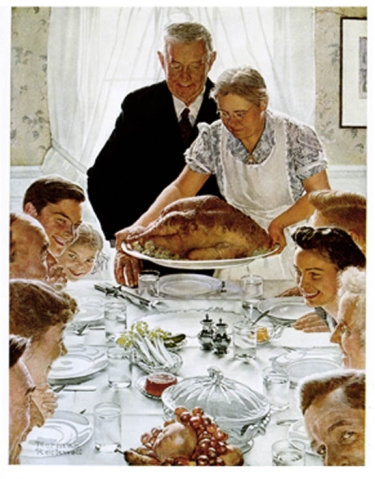


Necessaries:
Roasting pan deep enough to catch all drippings from turkey and wide enough that the whole bird is within its borders
Flat roasting rack for inside the pan (optional among the necessaries)
Aluminum foil
Meat thermometer
Ingredients:
1 10- to 20-pound turkey, spatchcocked
Butter or olive oil
Salt
Pepper
1 large baking potato
5-8 celery stalks
1 large white or yellow onion

This recipe will give you a delicious and juicy oven-roasted turkey, up to about 20 pounds, in under an hour and a half. We have a hang-up: Whether we know it or not, Norman Rockwell is in our heads. Especially at Thanksgiving, when we try, year after year, to produce a perfectly roasted whole turkey, just like in his painting. You know the one.
But seriously: Let it go. You can cook a turkey MUCH faster and make it much juicier by spatchcocking that bird.
Say what?
Spatchcocking. You heard right. Even SpellCheck doesn’t recognize this word, but the guy behind the meat counter knows what it means: to remove the backbone from your turkey. Although this is not terribly difficult, I do recommend that first-timers ask the butcher to do this for them. Just get a fresh (not frozen) turkey, and say something to the butcher like “Will you please spatchcock this turkey?” He’ll gladly do it right there before your wondering eyes.
The bird can then be cooked in one "slab," opened up and laid flat like a big, pink, Rorschach birdy-steak. This makes the thing cook evenly, without the bloody spots and dry spots inherent to cooking an intact, "round" bird. And it cooks much, much faster, which also means it doesn’t have enough time to dry out. So not only is it fast, it’s moist – all the good things.
HERE WE GO:
(Note: If your turkey is frozen, it must be completely thawed before you can start this process, so make sure to give the bird enough time. In this new world, the thawing is the longest part! Go figure.)
Preheat the oven to 450 degrees. Cut onion, potato and celery into one-inch slices or chunks, and lay them in a solid, uniform layer on the bottom of the roasting pan. This will keep the bird off the bottom of the pan. You will discard these bits after cooking the bird and capturing the drippings for gravy, if you're making it (of course you're making it). If you’re using a roasting rack, place it over the top of and in contact with the vegetables thus arranged; otherwise you can place the turkey straight onto the top of the veggie chunks (which is what I do). Either way, rack or no rack, the pan is now ready for the bird.
The goal is to lay the completely opened and flattened turkey in the pan, cavity side down. You may need to break or nick the inside of the breastbone (from the inside) just a bit to make it easier to lay the bird flat. Do not cut the thing completely in two, although it’s not the end of the world if you do. Just a tap with a sharp knife on the inside of the breastbone will get the flattening under way. Then turn the bird skin-side-up and press down on the center of the breast (do not hammer) until it lies down flat, as flat as you can get it. You may have to persuade it a bit, so don't wimp out. Get it flattened out. Once you're satisfied it's flat, then tuck the wingtips behind the rest of the wing so they don’t char during roasting.
Now rub the entire skin surface of the bird down with a stick of butter, then salt and pepper it liberally. Some of this will drain off during cooking. Finally, place a loose aluminum foil tent over the bird to keep the skin from browning too quickly. Be careful and try not to let the tent rest on the bird, because it can stick to it and take the skin off when you remove the tent (about halfway through baking).
Place the roasting pan/turkey/tent construct in the middle rack of your oven, with room for air to circulate on all sides. Bake at 450 degrees for 40 minutes or so, then remove the aluminum foil tent. Continue baking the turkey for a total of about 60 to 80 minutes, or until a meat thermometer registers recommended temperature (typically 165 degrees) for the thickest meat on the bird. Use a good thermometer, since your continued good health depends on a fully cooked bird.
Remove the roasting pan and turkey from the oven and let it cool for 20 to 30 minutes before slicing it artfully and arranging the turkey slices onto a serving platter. Then set the arranged platter onto the table, under the admiring gaze of your family and guests.









